National Oceanography Centre
-
- MTR100: National Oceanography Centre (UK) Marine Technology, Jun 2019 #64
National Oceanography Centre (UK)
Southampton, UK
President/CEO: Ed Hill OBE
No. of Employees: 620
www.noc.ac.uk
The National Oceanography Center (NOC) is the UK’s leading institution for integrated coastal and deep ocean research. NOC undertakes and facilitates world-class, agenda-setting scientific research to understand the global ocean by solving challenging multidisciplinary, large scale, long-term marine science problems to underpin international and UK public policy, business and wider societal outcomes. At the Marine Robotics Innovation Center in Southampton, the NOC hosts a community of 28 innovative partner companies, working in collaboration to develop next generation technology for platforms, components and sub-systems in order to advance oceanographic research for the benefit of both science and industry.The last 12 months has seen the NOC expand its reach and influence around the globe, with a number of overseas projects aimed at advancing marine science, capacity building and knowledge transfer under the SOLSTICE project focusing on the West Indian Ocean region, and the Commonwealth Marine Economies Program (CMEP) which is helping Commonwealth Small Island Developing States (SIDS) make the most of their natural maritime advantages. 2019’s STEMM-CCS expedition saw one of the largest deployments of bespoke oceanographic equipment aimed at furthering our understanding and capabilities within the field of subsea carbon capture and storage. Technology development with industry has seen innovative, low cost EcoSUB vehicles expand their networking capabilities, in partnership with Planet Ocean and the University of Newcastle. The NOC’s Autosub Long Range (ALR) successfully completed its first under ice mission in Antarctica. Another ALR project – P3NAV collaborating with Sonardyne and L3 ASV – has delivered advanced positioning capabilities without the need for surface vehicles.
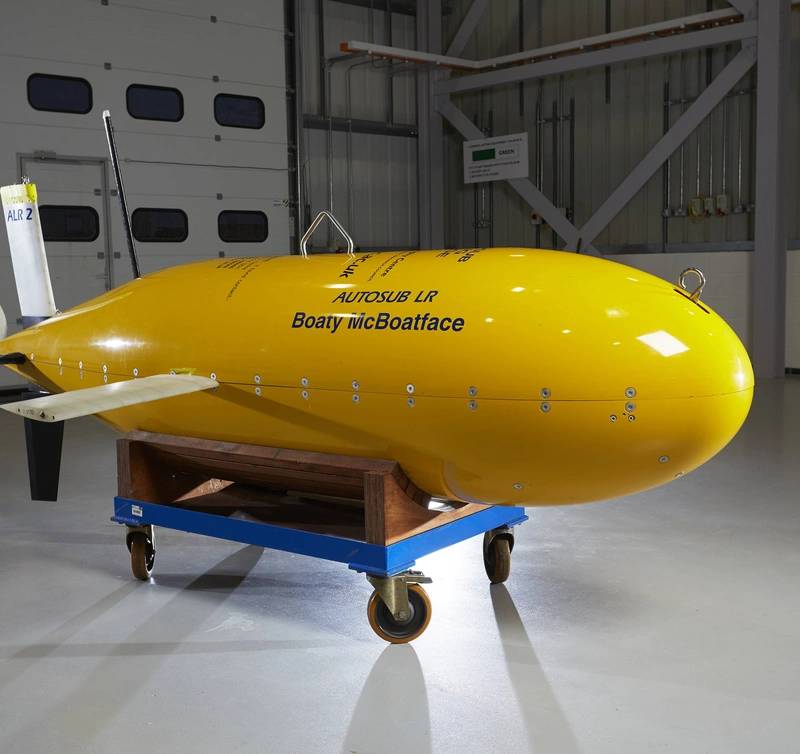 Image courtesy: National Oceanography Center (NOC)
Image courtesy: National Oceanography Center (NOC)The NOC is at the forefront of global marine technology development, with a focus on cutting-edge marine autonomous systems (MAS) and sensors. The Center is responsible for the development of the world-famous Autosub family of autonomous vehicles, including the pioneering Autosub Long Range vehicle, depth-rated to 6000 meters with extreme endurance capabilities and sophisticated payloads. Under the Oceanids programme, further platforms are under development that will deliver more advanced AI and navigation, greater endurance and range, and world-leading under-ice exploration capabilities. The program has also delivered a unified Command and Control (C2) infrastructure for operating a range of MAS, and related collaborative developments with industry are introducing improved networking capabilities, power consumption and endurance.
-
- Sonardyne System to Monitor North Sea CO2 Leaks Marine Technology, Jun 2014 #59
. Other members of the Consortium are lead participant Fugro GEOS Ltd., the National Environment Research Council (NERC – as represented by the National Oceanography Centre and British Geological Society), Plymouth Marine Laboratory and the University of Southampton. Using technologies already proven in the
-
- Preview: Ocean Business 2017 Marine Technology, Feb 2017 #16
, bringing together manufacturers and service providers in the industry. The exhibition center is located directly on the waterfront at the National Oceanography Centre. The exhibition provides visitors with the opportunity to see companies displaying the very latest in the industry all under one roof. More
-
- Seabed Imaging Re-imagined Marine Technology, Aug 2020 #44
these challenges.During its first 24-hour deployment, a BioCam fitted to an Autosub6000 autonomous underwater vehicle (AUV), from the UK’s National Oceanography Centre (NOC), mapped more than 50 times the area of a football pitch at photographic resolution – a rate 40 times that of conventional high resolution
-
- Mapping the Abyss with AUV Photography Marine Technology, Mar 2015 #32
areas reaching up to landscape scales. New Method for Deepsea Mapping A new photographic processing technique developed by scientists at the National Oceanography Centre (UK), used a camera on the Autosub6000 AUV to enable them to take a continuous stream of high resolution photographs of life on the sea
-
- Increased Confidence in CO2 Storage Marine Technology, Jul 2019 #22
but this time in as near to ‘real’ conditions as possible. During May this year, a research expedition set sail from the UK’s National Oceanography Centre in Southampton, aboard the RRS James Cook. Once on station, close to Shell’s Goldeneye platform approximately 100km off the coast
-
- MBARI Works at Unlocking Ocean Biology Marine Technology, Feb 2020 #42
organisms in the ocean, including understanding how and why harmful algae blooms form. Dr Birch spoke about the work and its results at the National Oceanography Centre’s Marine Autonomy and Technology Showcase (MATS) event in Southampton, late last year. The result is an Environmental Sample Processor (ESP)
-
- Drill Rig Noise: Entering the Exclusion Zone, Quietly Marine Technology, Mar 2020 #24
10 on the Beaufort Scale, during the first Marine Autonomous Systems in Support of Marine Observations (MASSMO) mission, co-ordinated by the National Oceanography Centre and run off the Isle of Scilly and they regularly work in Force 6 and 7. Projects the systems have worked on include science, civil
-
- View from the Top: Dan Hook, ASV Marine Technology, Mar 2016 #10
at the University of Southampton. The University had strong links with what was then the Southampton Oceanography Centre and is now the National Oceanography Centre. It was there that they developed the Autosub series of AUVs and this sparked my interest in unmanned systems. After graduating I worked
-
- Unmanned Surface Vessels: From Concept to Service Maritime Reporter, Feb 2016 #42
Vessels and the Ocean Environment In November 2015 a brand new Marine Robotics Innovation Centre was opened in Southampton, UK. Run by the National Oceanography Centre, the center will be will be a hub for businesses and technologists developing autonomous platforms with novel sensors that will be used
-
- Halls of Higher Learning Marine Technology, Aug 2016 #46
in earth and environmental research. QS World University Rankings 2016 in Earth & Marine Sciences placed UCSD as 14th in the world. The National Oceanography Centre (NOC) Topic: Marine Technology Address: University of Southampton, Southampton, Hampshire, SO14 3ZH, UK Tel: +44 (0)23 8059 6666 www
-
- MTR100: When it Comes to Drones, Big is Good. <1m is Better. Marine Technology, Jul 2021 #20
Defence Science and Technology Laboratory (UK MOD) funding and has collaborated with the Marine Autonomous Robotics Systems Group at the UK’s National Oceanography Centre.Its now commercial ecoSUBµ5 Micro-AUV is 92cm long, 4 kg in air, rated to 500 m depth, and able to operate for 12-20 hours (depending on
-
 )
May 2025 - Marine Technology Reporter page: 24
)
May 2025 - Marine Technology Reporter page: 24INTERVIEW ALEX PHILLIPS, NOC Inside the NOC ROBOTICS CENTER Much innovation in subsea robotics starts in academia, and the National Oceanography Centre in Southampton, UK, is a global leader with a ? eet of more than 40 systems and 60 engineers and scientists. Alex Phillips, is the Head
-
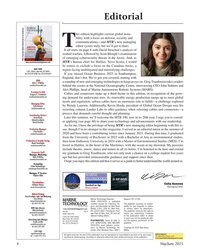 )
May 2025 - Marine Technology Reporter page: 4
)
May 2025 - Marine Technology Reporter page: 4and emerging technologies to keep an eye on. Greg Trauthwein takes readers John C. O’Malley [email protected] behind the scenes at the National Oceanography Centre, interviewing CEO John Siddorn and Alex Phillips, head of Marine Autonomous Robotic Systems (MARS). President & COO Cables and connectors
-
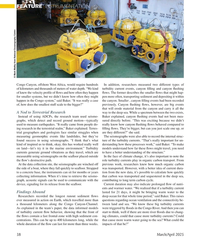 )
March 2025 - Marine Technology Reporter page: 38
)
March 2025 - Marine Technology Reporter page: 38FEATURE INSTRUMENTATION © Mark Maltby from National Oceanography Centre Congo Canyon, offshore West Africa, would require hundreds In addition, researchers measured two different types of of kilometers and thousands of meters of water depth. “We kind turbidity current events, canyon ? lling and canyon
-
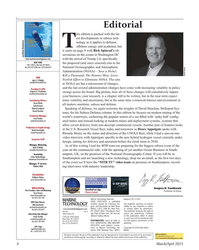 )
March 2025 - Marine Technology Reporter page: 4
)
March 2025 - Marine Technology Reporter page: 4.com year on the commercial side, with the opening of yet another Ocean Business in South- ampton, UK, on the premises of the National Oceanography Centre. If you will be in Accounting Esther Rothenberger Southampton and are launching a new technology, drop me an email, as the ? rst two
-
 )
March 2025 - Marine Technology Reporter page: 2
)
March 2025 - Marine Technology Reporter page: 2People & Company News 58 ROV Technology & Systems 63 Classi? eds 64 Advertisers Index Photo courtesy Mike Kozlowski © Mark Maltby from National Oceanography Centre March/April 2025 MTR #3 (1-17).indd 2 3/14/2025 11:57:20 A
-
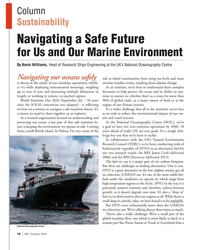 )
October 2024 - Marine News page: 18
)
October 2024 - Marine News page: 18Sustainability Navigating a Safe Future for Us and Our Marine Environment By Kevin Williams, Head of Research Ships Engineering at the UK’s National Oceanography Centre Navigating our oceans safely risk to island communities from rising sea levels and more is always at the center of our maritime operations
-
 )
September 2024 - Marine Technology Reporter page: 20
)
September 2024 - Marine Technology Reporter page: 20MTR 100 try standard 0.22 and 0.45 micron Sterivex ? lter cartridges for later eDNA analysis. A 2023 technology transfer from the National Oceanography Centre (NOC), RoCSI provides high sample count capability in a compact instrument. Wa- ter samples are collected and then biologically preserved
-
 )
September 2024 - Marine Technology Reporter page: 8
)
September 2024 - Marine Technology Reporter page: 8MTR 100 UK’s National Oceanography Centre (NOC) The UK’s National Oceanography Centre (NOC) is driving ogy and chemistry of the ocean. innovation in marine robotics and remote sensing to help Other projects ALRs have undertaken include a sea? oor expand the possibilities of sustained ocean exploration
-
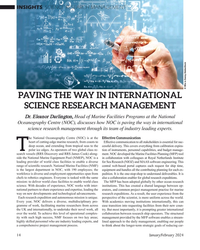 )
January 2024 - Marine Technology Reporter page: 14
)
January 2024 - Marine Technology Reporter page: 14(NOC), discusses how NOC is paving the way in international science research management through its team of industry leading experts. he National Oceanography Centre (NOC) is at the Effective Communication heart of cutting-edge marine research, from coasts to Effective communication to all stakeholders
-
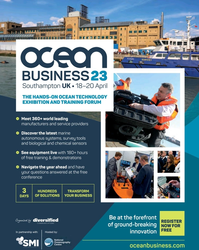 )
March 2023 - Marine Technology Reporter page: 62
)
March 2023 - Marine Technology Reporter page: 62National Oceanography Centre THE HANDS-ON OCEAN TECHNOLOGY EXHIBITION AND TRAINING FORUM G Meet 360+ world leading manufacturers and service providers G Discover the latest marine autonomous systems, survey tools and biological and chemical sensors G See equipment live with 180+ hours of free
-
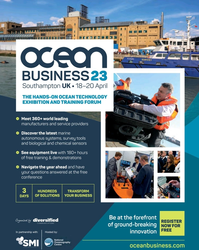 )
January 2023 - Marine Technology Reporter page: 9
)
January 2023 - Marine Technology Reporter page: 9National Oceanography Centre THE HANDS-ON OCEAN TECHNOLOGY EXHIBITION AND TRAINING FORUM G Meet 360+ world leading manufacturers and service providers G Discover the latest marine autonomous systems, survey tools and biological and chemical sensors G See equipment live with 180+ hours of free
-
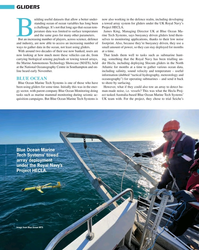 )
November 2022 - Marine Technology Reporter page: 28
)
November 2022 - Marine Technology Reporter page: 28been trialling un- the Marine Autonomous Technology Showcase (MATS), held der Hecla, including deploying Slocum gliders in the North at the National Oceanography Centre in Southampton and on- Atlantic for months at a time to gather various ocean data, line heard early November. including salinity, sound
-
 )
July 2022 - Marine Technology Reporter page: 39
)
July 2022 - Marine Technology Reporter page: 39that they same amount of space. For the same can’t be recharged. It was primary cells size vehicle you can go 30-50% further that the National Oceanography Centre with hydrogen than a battery powered (NOC) used on a recent trial of its Au- vehicle. That’s the big advantage and tosub Long Range 4
-
 )
July 2022 - Marine Technology Reporter page: 35
)
July 2022 - Marine Technology Reporter page: 35less critical, that’s not such an issue. Today, a primary cell lithium battery could get you close to 2,000 km on the AUV clock, as the UK’s National Oceanography Centre recently proved with its ALR4. But fuel cells capable of 5,000 km trips Cellula’s Solur-LR UUV are also looking attractive to some. A
-
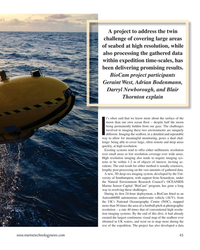 )
October 2020 - Marine Technology Reporter page: 45
)
October 2020 - Marine Technology Reporter page: 45these challenges. During its ? rst 24-hour deployment, a BioCam ? tted to an Autosub6000 autonomous underwater vehicle (AUV), from the UK’s National Oceanography Centre (NOC), mapped more than 50 times the area of a football pitch at photographic resolution – a rate 40 times that of conventional high resolu- ti
-
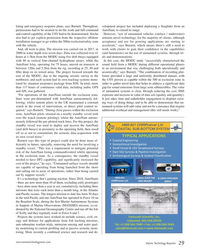 )
April 2020 - Marine Technology Reporter page: 29
)
April 2020 - Marine Technology Reporter page: 2910 on the Beaufort Scale, during the frst Marine Autonomous Systems in Support of Marine Observations (MASSMO) mission, co-or- dinated by the National Oceanography Centre and run off the Isle of Scilly and they regularly work in Force 6 and 7. Falmouth Scientific, Inc. Projects the systems have worked on
-
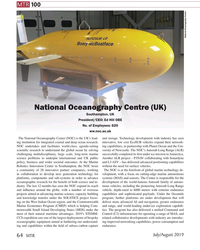 )
July 2019 - Marine Technology Reporter page: 64
)
July 2019 - Marine Technology Reporter page: 64MTR 100 National Oceanography Centre National Oceanography Centre (UK) Southampton, UK President/CEO: Ed Hill OBE No. of Employees: 620 ww.noc.ac.uk The National Oceanography Center (NOC) is the UK’s lead- and storage. Technology development with industry has seen ing institution for integrated coastal and
-
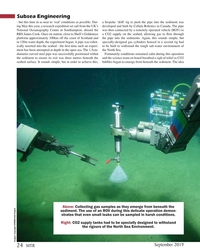 )
September 2019 - Marine Technology Reporter page: 24
)
September 2019 - Marine Technology Reporter page: 24the sediment was ing May this year, a research expedition set sail from the UK’s developed and built by Cellula Robotics in Canada. The pipe National Oceanography Centre in Southampton, aboard the was then connected by a remotely operated vehicle (ROV) to RRS James Cook. Once on station, close to Shell’s
-
 )
March 2019 - Marine Technology Reporter page: 3rd Cover
)
March 2019 - Marine Technology Reporter page: 3rd Coverfor developers, S2C communication and positioning emulator - 2019 remote access or standalone device 9 - 11 April 2019 - range: up to 8000 m National Oceanography Centre - depth: up to 6000 m Southampton, UK - data rate: up to 62.5 kbps Stand E6 EvoLogics GmbH tel.: +49 30 4679 862-0 Ackerstrasse 76, sales@evolo
-
 )
January 2019 - Marine Technology Reporter page: 3rd Cover
)
January 2019 - Marine Technology Reporter page: 3rd CoverCenter, CA Stand D32 - OCEAN BUSINESS range: up to 8000 m - depth: up to 6000 m 2019 - data rate: up to 62.5 kbps 9 - 11 April 2019 National Oceanography Centre Southampton, UK Stand E6 EvoLogics GmbH tel.: +49 30 4679 862-0 Ackerstrasse 76, [email protected] fax: +49 30 4679 862-01 13355 Berlin
-
 )
June 2018 - Marine Technology Reporter page: 8
)
June 2018 - Marine Technology Reporter page: 8technology Sonardyne; and the marine science research ect is to accelerate the wider adoption of unmanned systems and technology institution National Oceanography Centre and enable long term, low-cost survey and monitoring op- (NOC) are carrying out trials in Loch Ness in the Scottish erations for offshore
-
 )
March 2018 - Marine Technology Reporter page: 20
)
March 2018 - Marine Technology Reporter page: 20Credit: National Oceanography Centre This shows the trajectories of virtual oil particles released from (a) the ? nal resting site of the Sanchi (top-left; 14 January 2018 release) and (b) the vicinity of Amami-Oshima Island (bottom- right; 2 February 2018 release). For both panels, the colors indicate
-
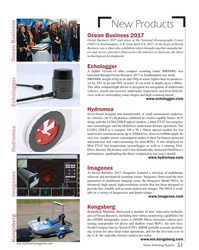 )
May 2017 - Marine Technology Reporter page: 51
)
May 2017 - Marine Technology Reporter page: 51New Products Ocean Business 2017 Ocean Business 2017 took place at the National Oceanography Centre (NOC) in Southampton, U.K. from April 4-6, 2017. At the heart of Ocean Business was a three-day exhibition which brought together manufactur- ers and service providers from across the industry to showcase
-
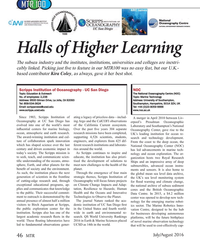 )
July 2016 - Marine Technology Reporter page: 46
)
July 2016 - Marine Technology Reporter page: 46contributor Kira Coley, as always, gave it her best shot. Scripps Institution of Oceanography - UC San Diego NOC Topic: Education & Outreach The National Oceanography Centre (NOC) No. of employees: 2,238 Topic: Marine Technology Address: 9500 Gilman Drive, La Jolla, CA 92093 Address: University of Southampton
